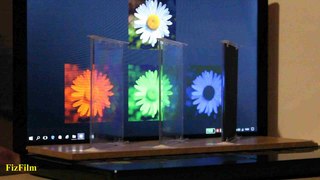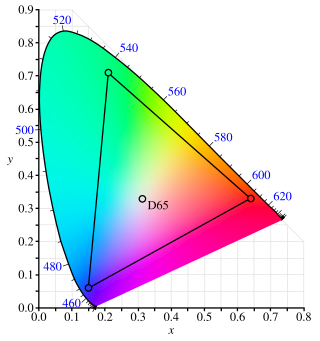
The RGB color model is an additive color model in which the red, green and blue primary colors of light are added together in various ways to reproduce a broad array of colors. The name of the model comes from the initials of the three additive primary colors, red, green, and blue.

The CMYK color model is a subtractive color model, based on the CMY color model, used in color printing, and is also used to describe the printing process itself. The abbreviation CMYK refers to the four ink plates used: cyan, magenta, yellow, and key (black).

JPEG 2000 (JP2) is an image compression standard and coding system. It was developed from 1997 to 2000 by a Joint Photographic Experts Group committee chaired by Touradj Ebrahimi, with the intention of superseding their original JPEG standard, which is based on a discrete cosine transform (DCT), with a newly designed, wavelet-based method. The standardized filename extension is .jp2 for ISO/IEC 15444-1 conforming files and .jpx for the extended part-2 specifications, published as ISO/IEC 15444-2. The registered MIME types are defined in RFC 3745. For ISO/IEC 15444-1 it is image/jp2.
The JPEG File Interchange Format (JFIF) is an image file format standard published as ITU-T Recommendation T.871 and ISO/IEC 10918-5. It defines supplementary specifications for the container format that contains the image data encoded with the JPEG algorithm. The base specifications for a JPEG container format are defined in Annex B of the JPEG standard, known as JPEG Interchange Format (JIF). JFIF builds over JIF to solve some of JIF's limitations, including unnecessary complexity, component sample registration, resolution, aspect ratio, and color space. Because JFIF is not the original JPG standard, one might expect another MIME type. However, it is still registered as "image/jpeg".
Tag Image File Format or Tagged Image File Format, commonly known by the abbreviations TIFF or TIF, is an image file format for storing raster graphics images, popular among graphic artists, the publishing industry, and photographers. TIFF is widely supported by scanning, faxing, word processing, optical character recognition, image manipulation, desktop publishing, and page-layout applications. The format was created by the Aldus Corporation for use in desktop publishing. It published the latest version 6.0 in 1992, subsequently updated with an Adobe Systems copyright after the latter acquired Aldus in 1994. Several Aldus or Adobe technical notes have been published with minor extensions to the format, and several specifications have been based on TIFF 6.0, including TIFF/EP, TIFF/IT, TIFF-F and TIFF-FX.
Color management is the process of ensuring consistent and accurate colors across various devices, such as monitors, printers, and cameras. It involves the use of color profiles, which are standardized descriptions of how colors should be displayed or reproduced.

The CIELAB color space, also referred to as L*a*b*, is a color space defined by the International Commission on Illumination in 1976. It expresses color as three values: L* for perceptual lightness and a* and b* for the four unique colors of human vision: red, green, blue and yellow. CIELAB was intended as a perceptually uniform space, where a given numerical change corresponds to a similar perceived change in color. While the LAB space is not truly perceptually uniform, it nevertheless is useful in industry for detecting small differences in color.
ColorSync is Apple Inc.'s color management API for the Mac OS and Mac OS X Operating Systems.

sRGB is a standard RGB color space that HP and Microsoft created cooperatively in 1996 to use on monitors, printers, and the World Wide Web. It was subsequently standardized by the International Electrotechnical Commission (IEC) as IEC 61966-2-1:1999. sRGB is the current defined standard colorspace for the web, and it is usually the assumed colorspace for images that are neither tagged for a colorspace nor have an embedded color profile.

The Adobe RGB (1998) color space or opRGB is a color space developed by Adobe Inc. in 1998. It was designed to encompass most of the colors achievable on CMYK color printers, but by using RGB primary colors on a device such as a computer display. The Adobe RGB (1998) color space encompasses roughly 50% of the visible colors specified by the CIELAB color space – improving upon the gamut of the sRGB color space, primarily in cyan-green hues. It was subsequently standardized by the IEC as IEC 61966-2-5:1999 with a name opRGB and is used in HDMI.
STEP-file is a widely used data exchange form of STEP. ISO 10303 can represent 3D objects in computer-aided design (CAD) and related information. Due to its ASCII structure, a STEP-file is easy to read, with typically one instance per line. The format of a STEP-file is defined in ISO 10303-21 Clear Text Encoding of the Exchange Structure.
A color model is an abstract mathematical model describing the way colors can be represented as tuples of numbers, typically as three or four values or color components. When this model is associated with a precise description of how the components are to be interpreted, taking account of visual perception, the resulting set of colors is called "color space."
PDF/A is an ISO-standardized version of the Portable Document Format (PDF) specialized for use in the archiving and long-term preservation of electronic documents. PDF/A differs from PDF by prohibiting features unsuitable for long-term archiving, such as font linking and encryption. The ISO requirements for PDF/A file viewers include color management guidelines, support for embedded fonts, and a user interface for reading embedded annotations.
In color management, an ICC profile is a set of data that characterizes a color input or output device, or a color space, according to standards promulgated by the International Color Consortium (ICC). Profiles describe the color attributes of a particular device or viewing requirement by defining a mapping between the device source or target color space and a profile connection space (PCS). This PCS is either CIELAB (L*a*b*) or CIEXYZ. Mappings may be specified using tables, to which interpolation is applied, or through a series of parameters for transformations.

A color space is a specific organization of colors. In combination with color profiling supported by various physical devices, it supports reproducible representations of color – whether such representation entails an analog or a digital representation. A color space may be arbitrary, i.e. with physically realized colors assigned to a set of physical color swatches with corresponding assigned color names, or structured with mathematical rigor. A "color space" is a useful conceptual tool for understanding the color capabilities of a particular device or digital file. When trying to reproduce color on another device, color spaces can show whether shadow/highlight detail and color saturation can be retained, and by how much either will be compromised.
PDF/VT is an international standard published by ISO in August 2010 as ISO 16612-2. It defines the use of PDF as an exchange format optimized for variable and transactional printing. Built on top of PDF/X-4, it is the first variable-data printing (VDP) format which ensures modern International Color Consortium-based (ICC) color management through the use of ICC Output Intents. It adds the notion of encapsulated groups of graphic objects to support optimized efficient processing for repeating text, graphic or image content. Introducing the concept of document part metadata (DPM), it enables reliable and dynamic management of pages for High Volume Transactional Output (HVTO) print data, like record selection or postage optimization based on metadata.
A color appearance model (CAM) is a mathematical model that seeks to describe the perceptual aspects of human color vision, i.e. viewing conditions under which the appearance of a color does not tally with the corresponding physical measurement of the stimulus source.
Media Standard Print is a publication of the Bundesverband Druck und Medien (BVDM), available on its website. The publication contains instructions on how to produce data and proofs that are to be sent to a printer. It is based on ProcessStandard Offset and therefore on the ISO standards 12647 and 15930. As such, it serves as the foundation for smooth cooperation between customer, prepress service provider and printer during media production, covering data formats, colour spaces, printing conditions, workflows, means of proofing, standards, black composition and much more.
The European Color Initiative (ECI) is an expert group that is concerned with media-neutral reproduction of color data in digital publication systems. It was formed in June 1996 by German publishers Bauer, Burda, Gruner + Jahr and Springer in Hamburg.






